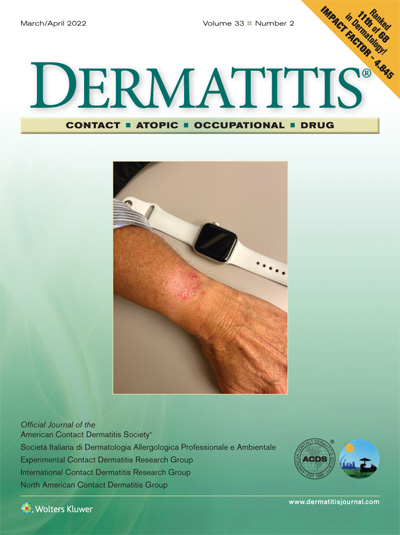The Role of OX40-OX40L Axis in the Pathogenesis of Atopic Dermatitis.
IF 3.2
3区 医学
Q1 DERMATOLOGY
引用次数: 0
Abstract
OX40 is a co-stimulatory immune checkpoint molecule that promotes the activation and the effector function of T lymphocytes through interaction with its ligand (OX40L) on antigen-presenting cells. OX40-OX40L axis plays a crucial role in Th1 and Th2 cell expansion, particularly during the late phases or long-lasting response. Atopic dermatitis is characterized by an immune dysregulation of Th2 activity and by an overproduction of proinflammatory cytokines such as interleukin (IL)-4 and IL-13. Other molecules involved in its pathogenesis include thymic stromal lymphopoietin, IL-33, and IL-25, which contribute to the promotion of OX40L expression on dendritic cells. Lesional skin in atopic dermatitis exhibits a higher level of OX40L+-presenting cells compared with other dermatologic diseases or normal skin. Recent clinical trials using antagonizing anti-OX40 or anti-OX40L antibodies have shown symptom improvement and cutaneous manifestation alleviation in patients with atopic dermatitis. These findings suggest the relevance of the OX40-OX40L axis in atopic dermatitis pathogenesis.OX40-OX40L 轴在特应性皮炎发病机制中的作用
OX40 是一种协同刺激免疫检查点分子,它通过与抗原递呈细胞上的配体(OX40L)相互作用,促进 T 淋巴细胞的活化和效应功能。OX40-OX40L 轴在 Th1 和 Th2 细胞扩增中发挥着关键作用,尤其是在晚期或持久反应期间。特应性皮炎的特点是 Th2 活性的免疫调节失调以及白细胞介素(IL)-4 和 IL-13 等促炎细胞因子的过度产生。其他参与发病的分子包括胸腺基质淋巴细胞生成素、IL-33 和 IL-25,它们有助于促进树突状细胞上 OX40L 的表达。与其他皮肤病或正常皮肤相比,特应性皮炎的病变皮肤显示出更高水平的 OX40L+ 呈递细胞。最近使用抗 OX40 或抗 OX40L 抗体进行的临床试验显示,特应性皮炎患者的症状有所改善,皮肤表现有所减轻。这些研究结果表明,OX40-OX40L 轴与特应性皮炎的发病机制有关。
本文章由计算机程序翻译,如有差异,请以英文原文为准。
求助全文
约1分钟内获得全文
求助全文
来源期刊

Dermatitis
医学-皮肤病学
CiteScore
5.30
自引率
11.50%
发文量
251
审稿时长
>12 weeks
期刊介绍:
Dermatitis is owned by the American Contact Dermatitis Society and is the home journal of 4 other organizations, namely Societa Italiana di Dermatologica Allergologica Professionale e Ambientale, Experimental Contact Dermatitis Research Group, International Contact Dermatitis Research Group, and North American Contact Dermatitis Group.
Dermatitis focuses on contact, atopic, occupational, and drug dermatitis, and welcomes manuscript submissions in these fields, with emphasis on reviews, studies, reports, and letters. Annual sections include Contact Allergen of the Year and Contact Allergen Alternatives, for which papers are chosen or invited by the respective section editor. Other sections unique to the journal are Pearls & Zebras, Product Allergen Watch, and news, features, or meeting abstracts from participating organizations.
 求助内容:
求助内容: 应助结果提醒方式:
应助结果提醒方式:


